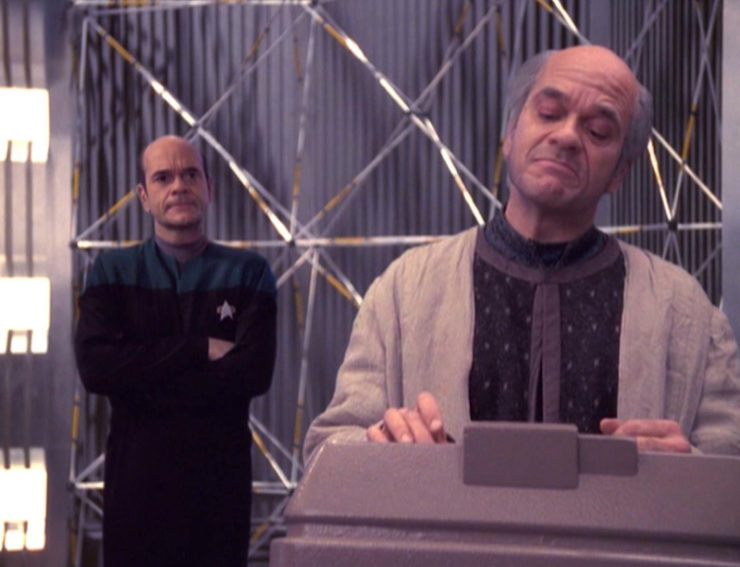“Life Line”
Written by John Bruno & Robert Picardo and Robert Doherty, Raf Green, & Brannon Braga
Directed by Terry Windell
Season 6, Episode 24
Production episode 243
Original air date: May 10, 2000
Stardate: unknown
Captain’s log. A shuttlecraft arrives at Jupiter Station piloted by Barclay, who’s there to visit Dr. Lewis Zimmerman, whom, we learn, is dying of an illness that has baffled all the doctors in the Alpha Quadrant.
Meanwhile, in the Delta Quadrant, the Pathfinder Project has found a way to regularly contact Voyager. The MIDAS Array is using a cyclic pulsar to punch a datastream across the 30,000 light-years to Voyager, but they will only be able to do so every thirty-two days or so, and Voyager will have a seventeen-hour window to reply.
Neelix distributes the letters from home that people got, including one to the EMH from Barclay informing him that Zimmerman is dying. Zimmerman’s medical records are included.
After examining those records, the EMH goes to Janeway with a proposal: send him back as a datastream, like they did back in “Message in a Bottle.” It would mean that it would be the only thing that could go back to the Alpha Quadrant, as there wouldn’t be space for any other data (like letters home), and the ship would also be without their doctor for a month. But Paris has already agreed to cover sickbay, and the EMH is sure that the crew can wait another month to send their letters, which is a pretty big ask. But Zimmerman doesn’t have a month.
Janeway agrees to let him go for reasons passing understanding. Seven has to remove several of his subroutines in order for his matrix to be small enough to fit in the datastream. The EMH is reluctant to allow that, but eventually capitulates that he won’t be singing, reciting poetry, painting, or playing chess.
Voyager transmits him to the Alpha Quadrant, and Barclay brings him to Jupiter Station. Zimmerman’s assistant, Haley, cautions Barclay that Zimmerman doesn’t want visitors, but also asks Zimmerman to be nice to Barclay, because the lieutenant cares about him.
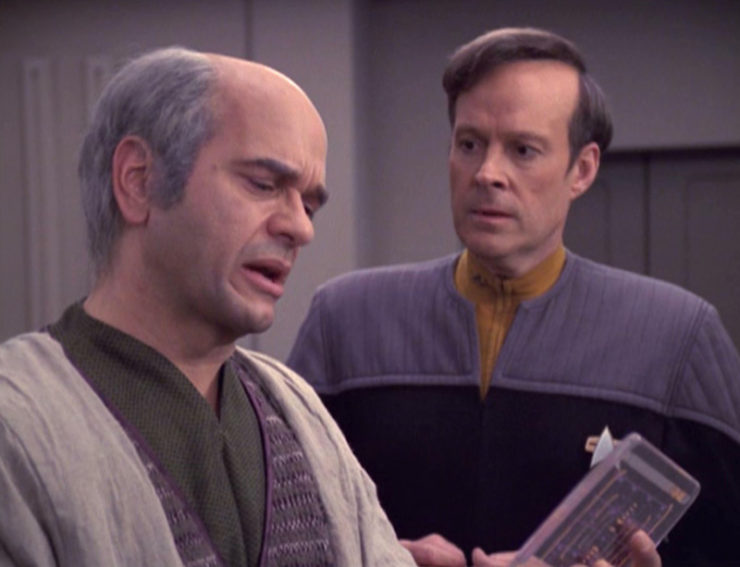
However, Zimmerman is very much not pleased to see the EMH. It turns out that the reason why there was an EMH Mark 2 on the Prometheus is because Starfleet rejected the EMH Mark 1, and has consigned them to scrub plasma conduits on waste transfer barges. Zimmerman has no desire to be treated by an obsolete model.
Zimmerman refuses to be treated by the EMH no matter how many times he asks or tries. After a few days, the EMH begs to be sent back to Voyager, but that can’t happen until the thirty-two-day window reopens. We also learn that Zimmerman’s pet iguana Leonard, who talks, is a hologram, as is a fly that keeps buzzing around the EMH.
A comment from the EMH that what Zimmerman really needs is a counselor prompts Barclay to contact Troi on the Enterprise. She agrees to come by, though she won’t be there for two weeks.
That fortnight passes frustratingly. At one point Zimmerman recalibrates the EMH’s medical tricorder so it reads Zimmerman as a Vulcan marsupial. Another time the EMH changes his appearance to that of a pretty alien masseuse in order to get close enough to Zimmerman to examine him.
Finally, Troi shows up—Zimmerman pinches her, thinking she’s another hologram—and tries to help out, but the dual snottiness does even her in, and she explodes and calls them both jerks.
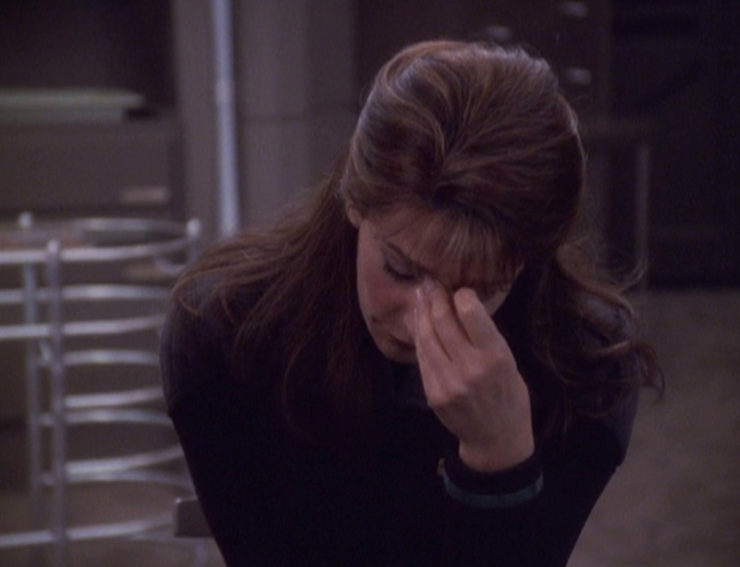
Troi does, at least, help the EMH understand why Zimmerman is reluctant to use an older model of EMH when there are three generations past it. But then she speaks to Haley, whom she knows is also a hologram—her empathic senses don’t detect her—and is surprised to learn that Haley has been Zimmerman’s holographic assistant for nine years. That’s longer than the EMH Mark 1 has been in service. So why is he okay with Haley but not the EMH?
Haley has the answer: he put everything into the Mark 1, even giving it his appearance and personality. When Starfleet rejected it and reassigned it to cleaning toilets, he was devastated.
Buy the Book


A Psalm for the Wild-Built
Back on Voyager, Janeway shows Chakotay the message they received from Admiral Hayes. Two deep-space vessels have been directed toward Voyager’s position, and should rendezvous with them in five or six years. Hayes also asks for a casualty list, information about their first contacts, and how the Maquis crew is doing. Janeway is taken aback by the specific mention of the Maquis, as Janeway doesn’t think of Chakotay, Torres, and the rest as anything but her crew. Chakotay allows as how the Maquis crew have not forgotten why they were being chased in the Badlands.
The EMH has retreated into Barclay’s Voyager holodeck re-creation. Troi tries to convince him to join her, Barclay, Haley, and Zimmerman for dinner, but the EMH isn’t interested. However, as they’re talking, the EMH’s holographic matrix futzes out.
Barclay can’t fix it, and so he, Troi, and Haley go to Zimmerman, who refuses. (“Good riddance to bad photons.”) When reminded that Voyager needs him, Zimmerman says he’ll send them a Mark 4. But they don’t want a Mark 4, they want their friend back. Zimmerman angrily retorts that he’s nobody’s friend, he’s just a hologram.
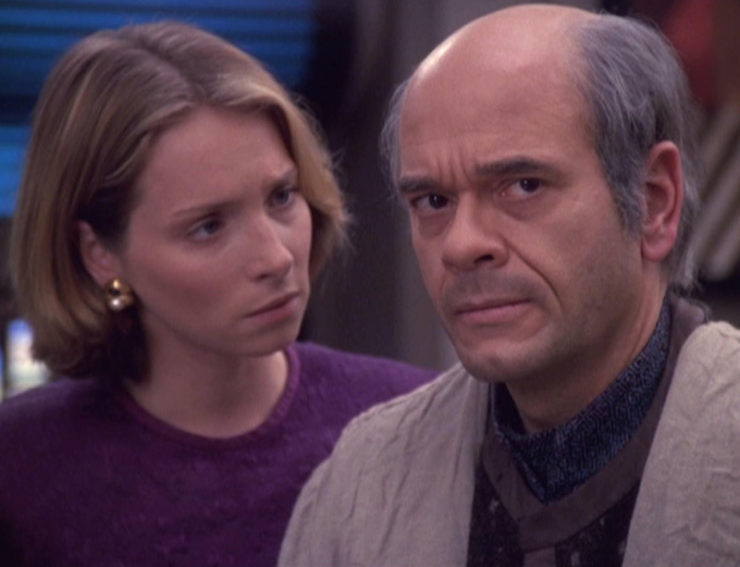
This cuts Haley to the quick, and she reminds Zimmerman that he cut short a lecture on Vulcan when he heard that Haley’s matrix was destabilizing. Zimmerman finally relents. He repairs the EMH, and also creates some new subroutines for him. But the EMH doesn’t want those subroutines, he likes himself the way he is. Zimmerman finally admits that he is embarrassed by Starfleet’s rejection of the Mark 1, with nicknames like “Emergency Medical Hothead” and “Extremely Marginal House-calls.” To know that his face is out there cleaning toilets rather than saving lives like he’d intended.
The EMH points out that he, at least, is saving lives, and has done a damn fine job of it. Zimmerman finally agrees to be treated.
After setting Zimmerman on the course to a cure, and before he goes back to Voyager, the EMH confronts Barclay and Troi. Zimmerman discovered that the depolarization of the EMH was done deliberately. They admit to creating a problem for Zimmerman to solve as a way of getting him to get his head out of his ass.
Can’t we just reverse the polarity? Zimmerman has created all kinds of holograms, from an assistant to a pet to an irritant.
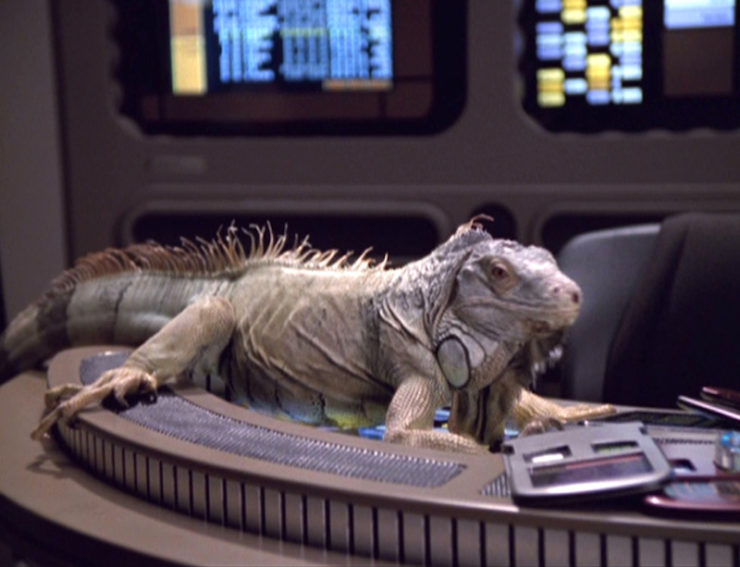
There’s coffee in that nebula! Janeway met Zimmerman at a conference once. He apparently offended everyone there, and also called her “Captain Jane,” which she thinks he did to annoy her. This actually retroactively makes Janeway’s reluctance to treat the EMH like a person in the early seasons a bit more understandable.
Everybody comes to Neelix’s. When discussing Barclay’s Voyager simulation, the EMH comments that Neelix doesn’t purr in real life, but Troi explains that Barclay named his cat after the Talaxian, as seen in “Pathfinder.”
Please state the nature of the medical emergency. Zimmerman has created a Mark 3 and a Mark 4 EMH, beyond the Mark 1 we’ve been seeing all along and the Mark 2 we met in “Message in a Bottle.”
Resistance is futile. When Seven observes that the EMH and Zimmerman “bear a striking resemblance,” the EMH replies that it’s so a doctor will inspire confidence in his patients. “Compassionate eyes and a strong chin can go a long way.” Seven’s look of massive dubiousness in response to this is epic.
What happens on the holodeck stays on the holodeck. The EMH doesn’t comment on the Maquis crew wearing civilian garb in Barclay’s Voyager holodeck re-creation, which is kinda too bad…
Do it.
“I came here thinking that you were opposite sides of the same coin—identical, but different. Now I see you’re both exactly the same: you’re both jerks!”
–Troi psychoanalyzing the EMH and Zimmerman both
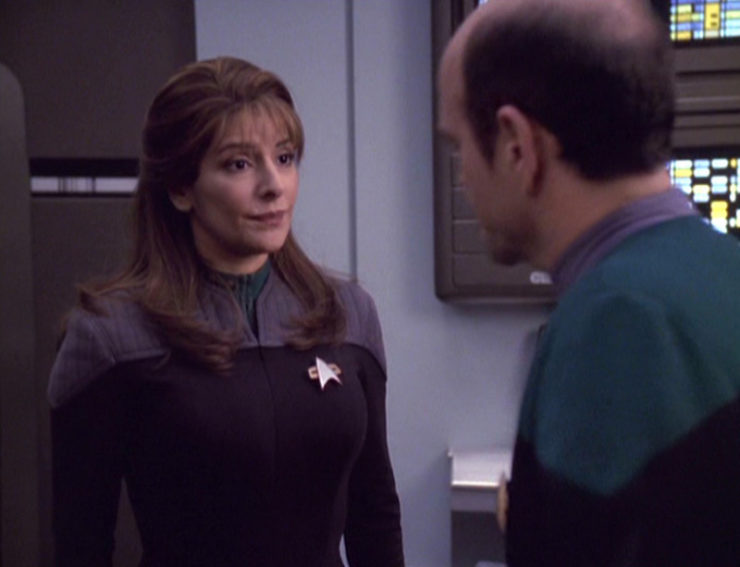
Welcome aboard. Dwight Schultz and Marina Sirtis return as Barclay and Troi, both last seen earlier this season in “Pathfinder.” Both will next appear in “Inside Man.” Jack Shearer is also back as Hayes, last seen in “Hope and Fear.” Tamara Craig Thomas plays Haley, while Robert Picardo does double duty as both the EMH and Zimmerman.
Trivial matters: This is Lewis Zimmerman’s only actual appearance on Voyager. A holographic version of the character appeared in “The Swarm” (and, sort of, in “Projections“), while the character also appeared in DS9’s “Dr. Bashir, I Presume?”
Speaking of that DS9 episode, Zimmerman says he hasn’t been off Jupiter Station in four years—”Dr. Bashir, I Presume?” was four years earlier, so that tracks, and it means he hasn’t been off the station since his visit to Deep Space 9 to interview Bashir.
This is one of only three Trek episodes where one of the actors has a writing credit. The others are the animated episode “The Infinite Vulcan,” written by Walter “Chekov” Koenig, and DS9’s “The Muse,” where Majel “Lwaxana” Barrett got co-story credit as Robert Picardo does here.
Picardo’s story credit is shared with John Bruno, who directed the previous episode “Fury,” as well as the EMH-centered “Tinker Tenor Doctor Spy.” It remains Bruno’s only writing credit in his entire career to date.
This is the first time the Pathfinder Project has been seen since “Pathfinder,” and the episode makes it clear that this is the project’s first communication with Voyager since then. From this point on, there will be regular contact between Voyager and Starfleet.
Barclay’s re-creation of Voyager was last seen in “Pathfinder.”
The EMH notes that Zimmerman’s illness is similar to the Phage suffered by the Vidiians, as seen in “Phage” and elsewhere, and his solution involves the magical mystery Borg nanoprobes.
Zimmerman mistakenly refers to Voyager as Pioneer. The first NASA spacecraft to leave the solar system was the Pioneer program, and its followup was Voyager.
It is likely that Leonard the holographic iguana was named after Dr. McCoy from the original series.
The masseuse the EMH disguises himself as is a Tarlac, as seen in the movie Insurrection.
This episode was nominated for an Emmy for Outstanding Visual Effects.
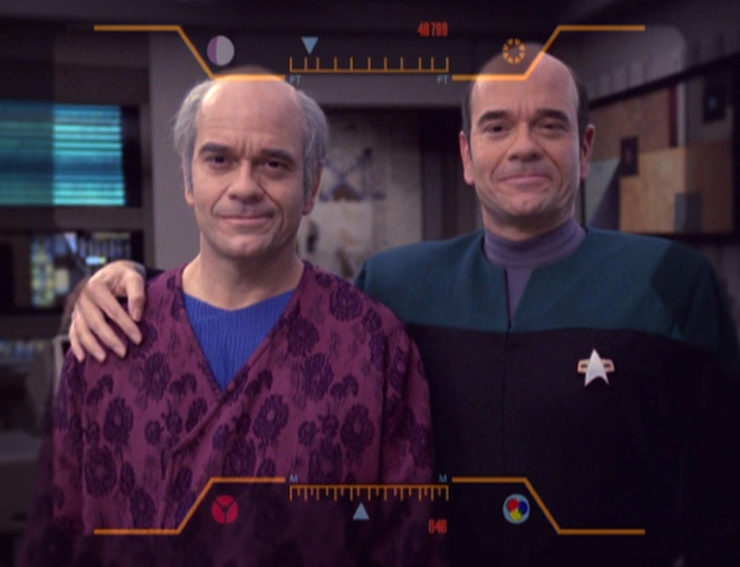
Set a course for home. “Computer, deactivate iguana.” This episode is tremendous fun to watch. Any episode that focuses on Robert Picardo being snotty is pretty likely to be a winner, and this one has Picardo being snotty twice over!
Really, that’s all there is to say about the main plotline. It’s just a vehicle for Picardo to do a double act with himself. (The actor himself joked that, “I achieved a lifelong ambition of working with an actor who I’ve admired.”) That and we get more of Barclay and Troi, which is never a bad thing. Dwight Schultz is unusually subdued in this one—though, to be fair, he can hardly get a word in—and it’s nice to get a Barclay story that isn’t about his neuroses. Barclay here is just being a good person and a good friend. And Marina Sirtis is a delight—I especially like her coming out and calling both the EMH and Zimmerman jerks. It’s not very professional, but it was definitely deserved. And in general, Troi does good work here. The script is excellent, full of snappy patter and great one-liners for both of Picardo’s characters.
There are two major problems with the episode, though, and made me struggle with the rating. (I was never going higher than 7, but the problems I’m about to enumerate almost brought it down lower. As it is, I’m still torn about it…)
The first is the idiotic notion that a series of holographic programs would be “sent” to scrub toilets. That makes no sense on any possible level, not from a technological standpoint (wouldn’t they have automatons for that?), and not from a moral standpoint (why would you give that task to something with a personality?). Also, they’re all tethered to their respective sickbays, so why would they need to be “sent” anywhere? Why not just turn them off?
I have a much bigger issue with the scene back on Voyager with Janeway and Chakotay watching the message from Hayes. One of the things Hayes asks for is a casualty list. “I’m sure you’ve had more than your share.”
Voyager has had two communications with the Alpha Quadrant: the EMH’s debriefing in “Message in a Bottle” and the first success of the Pathfinder Project in “Pathfinder.” How is it possible that nobody ever mentioned who died either of those times? Hell, the EMH has to have that information readily to hand in his memory. How can they not have provided that information? Does that mean that the families of Cavit, Stadi, Durst, Ballard, Kaplan, and all the other folks who’ve been killed sent letters to them, not knowing that they were dead? Did Voyager not bother to inform them of this after those letters came in?
Worse, Janeway makes absolutely no mention of those casualties in her conversation because she’s much more concerned about how Starfleet will react to the Maquis crew. So, to be clear, she’s way more worried about a hypothetical Starfleet reaction many years hence to the Maquis being part of her crew than she is about the fact that more than twenty people have died on her watch, and she hasn’t even bothered to tell Starfleet about it?
Still, even with those two annoyances, this is a fun episode, one that shares its DNA with a few other Trek episodes—particularly TNG’s “Brothers” in terms of plot structure and the original series’ “The Ultimate Computer” in terms of the burdens of genius—but works quite well on its own as an exploration of the EMH’s unexpected filial responsibilities and Zimmerman’s depression at what he sees as a failure.
Warp factor rating: 7
Keith R.A. DeCandido has a story in the upcoming anthology Devilish and Divine, which features stories about angels and demons, which is now available for preorder from eSpec Books. Keith read his story, “Unguarded,” as part of his KRAD COVID readings series of short fiction readings on YouTube.










